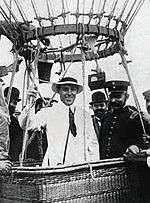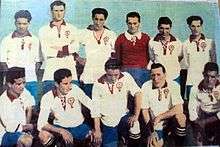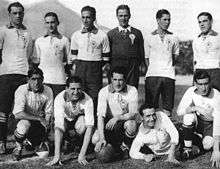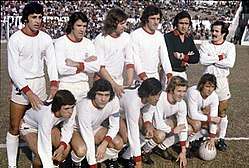Club Atlético Huracán
 | ||||
| Full name | Club Atlético Huracán | |||
|---|---|---|---|---|
| Nickname(s) |
Globo ("Balloon") Quemeros ("Burners") | |||
| Founded | 1 November 1908 | |||
| Ground |
Tomás A. Ducó, Parque Patricios, Buenos Aires | |||
| Capacity | 48,314 | |||
| Chairman | Alejandro Nadur | |||
| Manager | Gustavo Alfaro | |||
| League | Primera División | |||
| 2017–18 | 4th | |||
| Website | Club website | |||
|
| ||||
| Active departments of C.A. Huracán | ||||||||||||||||||||||||
|---|---|---|---|---|---|---|---|---|---|---|---|---|---|---|---|---|---|---|---|---|---|---|---|---|
|
Club Atlético Huracán (Spanish pronunciation: [uɾaˈkan]) is an Argentine sports club from the Parque Patricios neighbourhood of Buenos Aires. The club is notable for its football team, that currently plays in the Primera División, the top level of the Argentine football league system. Its home stadium is the Estadio Tomás Adolfo Ducó.
Huracán was founded on 1 November 1908 in the Nueva Pompeya neighbourhood of Buenos Aires. The club's name and nickname (Globo, literally "Balloon") comes from the Huracán ("Hurricane") balloon flown by Jorge Newbery in 1909. Its supporters are called los Quemeros ("the Burners") because the stadium is located in a former garbage burning area.
Since its establishment, Huracán has won 13 domestic titles (including five Primera División championships, and most recently the 2014 Supercopa Argentina). Apart from those achievements, the team has finished as runner-up of the top division seven times (the last one in the 2009 Clausura). Huracán's historical rival is San Lorenzo de Almagro.
Other sports practised at the club are artistic gymnastics, boxing, field hockey, roller hockey, handball, martial arts and volleyball.
History
First steps

On 25 May 1903, a group of boys from Nueva Pompeya, Buenos Aires, founded a football club under the name Los Chiquitos de Pompeya.[1] In 1907 the name was changed to Verde esperanza y no pierde.
On 1 November 1908, a meeting was organised, and therefore the club was named "Club Atlético Huracán", according to club's certificates, signed by José Laguna as the first president of the institution. In that meeting the white color with a balloon emblem on the chest, was also established as club's jersey.[1] This was established as the official foundation of Huracán. Likewise, the balloon emblem was a homage to Argentine aviation-pioneer Jorge Newbery's, which had been brought from France and first piloted by Newbery in 1909. The club asked Newbery for permission to use the balloon, which Newbery replied saying "I gave my most complete approval to the request, hoping that the team will honor the balloon that crossed three countries (Argentina, Uruguay and Brazil) in a unique trip". When Huracán reached the first division, the managers sent a letter to Jorge Newbery that said: "Huracán has kept its promise, promoting three divisions, as your balloon crossed three republiques before, so your wish was accomplished" [2]
In 1910, Jorge Newbery was named "protector member" of the club. That same year Huracán played in the Liga 43, where 43 clubs from second and fourth divisions took part of the championship. Huracán played its first matches in a field located in Cachi and Traful streets. It was Jorge Newbery who got the lands on Arena street. Newbery also negotiated the affiliation of the club to Argentine Football Association. In 1912 Huracán debuted in the third division, which only allowed under-18 players to participate.
Primera División & golden age



Huracán reached the Argentine Primera División two years later, debuting in the top division on 29 March 1914, with a 4–2 over Ferro Carril Oeste. The team finished 6th of 13 with 4 games won, five lost and three drew.[3] The following seasons, Huracán made good campaigns, even finishing third in 1917 and 1919. In 1920 the team made a great season, finishing runner-up of Boca Juniors but also winning its first title ever, the Copa Estímulo, awarded to the club after Banfield resigned to play the final game.[4]
But the first league title (and the second in club's history) would be win a year after, when Huracán was crowned champion after a great campaign that include 14 victories and only one loss in 18 matches played. The team also reached a mark of 54 goals (an average of three per game).[5] Huracán also had the topscorer of the tournament, Guillermo Dannaher with 23 goals.[6]
Just one season after, Huracán won another championship, the 1922 Primera División, winning 13 of 16 matches played with only one loss.[7] In 1923 the tournament was suspended with Huracán placed first and Boca Juniors in the second position. Therefore, both teams have to play a match in order to crown a champion, which was finally won by the Xeneize 2–0. That same year the club also won the Copa Dr. Carlos Ibarguren, defeating Newell's Old Boys by 1–0 after a 1–1 tie in the first match.[8][9]
The third Primera División title for the club came in 1925, after a playoff match where Huracán defeated Nueva Chicago due to both teams had finished in the first position at the end of the tournament. The playoff match was played at Sportivo Barracas stadium. Huracán had finished the regular season with 18 games won, two drew and one loss over 21 games played. The team scored 51 goals and conceded only 12.[10] Huracán also won the Copa Dr. Ibarguren defeating Rosarino team Tiro Federal by 2–1 (goals by Stábile and Pratto).[11]
The team made good campaigns during the successive years, and in 1928 Huracán won its 4th. Primera División title, after a long season of 35 games played. Huracán won 28 games, with 2 drew and 5 lost, scoring 73 goals (far from runner-up Boca Juniors that scored 100 goals with the same quantity of matches won). Some highlights for the team include victories over Boca Juniors (3–1), River Plate (2–0), Lanús (7–2). Guillermo Stábile was team's topscorer with 24.[12]
The team was one of the most successful teams during those years, winning four titles and always finishing in the top-ten with the exception of 1930 when it was placed 14th. One of its most notable players was Guillermo Stábile, club's top scorer before being traded to Genoa in 1930.
1929–72
Huracán did not got any important achievement during the first years of professional era. In 1939, with Tomás Ducó as president, Huracán acquired the lands where the club would later built its facilities and stadium (later named "Tomás Ducó" honoring him). The works finished in September 1947 with a celebration that included a friendly match against Boca Juniors.
In 1949 Huracán finished last along with Lanús so both teams had to play two matches in order to define which team would be relegated to second division. After one victory per-each and a 3–3 draw, a fourth game had to be played, with Huracán winner by a score of 3–2, which sent Lanús to Primera B.[13]
Other important facts in club's history were the debuts of two notable players: Alfredo Di Stéfano in 1946 and Adolfo Pedernera in 1948.
During the decade of the 1950s Huracán came close to being relegated, but managed keep its place in the top division. Huracán defeated Tigre in 1950 and then beat Quilmes a year later. The most important achievement during those years was 3rd place in 1952, shared with Independiente.[14]
In the decade of the 1960s Huracán did not make great campaigns, the club's best performance being 6th place in 1963. In 1967 a restructuring of the tournaments was carried out by the Football Association, creating the Metropolitano and Nacional championships. During the 1969 tournament, two historical players of the club such as Miguel Brindisi and Carlos Babington played together for the first time.
The revolution of Menotti

In 1971 César Menotti was hired as coach by then president Luis Seijo. Menotti started a process that ended successfully in 1973, when Huracán won its second league title in club's history the 1973 Metropolitano championship. That squad is widely regarded as one of the best Argentine teams ever, with key players such as René Houseman, Carlos Babington, Miguel Brindisi and Omar Larrosa.[15][16]
| “ | I am convinced that all Argentine teams are able to play a football that gives show; a kind of funny football, like the style Huracán plays | ” |
| — César Menotti, 1973 [17] | ||
The most frequent line-up of Huracán in 1973 was: Héctor Roganti, Nelson Chabay, Daniel Buglione, Alfio Basile, Jorge Carrascosa, Miguel Brindisi, Francisco Russo, Carlos Babington; René Houseman, Roque Avallay, Omar Larrosa. The team finished with 46 points (four more than runner-up Boca Juniors) with 19 matches won and five loses.[18][19]
With a team formed with most of the players that had won the title, Huracán reached the semifinals in the 1974 Copa Libertadores being later eliminated by Independiente (which would be the champion) and Peñarol. In domestic competitions, Huracán was runner-up in 1975 Metropolitano and 1976 Metropolitano. Some of the most notable players of that time were Osvaldo Ardiles and goalkeeper Héctor Baley, both of whom would win the 1978 World Cup playing for Argentina national football team.
Relegations
The 1980s was not a good decade for the club. Huracán was relegated for the first time to the second division, Primera B Nacional in 1986. The team played four years there until Huracán won the promotion to Primera in 1990, being coached by former player and idol Carlos Babington. Some of its most notable players were Antonio Mohamed and Fernando Quiroz.
Coached by former player Héctor Cúper, Huracán was 1994 Torneo Clausura runner-up after a great campaign during that season, losing the chance in the last fixture when the Parque Patricios' team was hardly defeated by Independiente (which became champion) 4–0, in a match played in Estadio Libertadores de América.
In 1999 Huracán was relegated to B Nacional again, although the club would be promoted one season later, coached by Babington again. A new crisis due to internal and financial problems led to relegation in 2003. The club spent four seasons in the B Nacional until 2007, when the club promoted to Primera after defeating Godoy Cruz in playoffs with scores of 2–0 in Parque Patricios and 3–2 in Mendoza.[20] Huracán was coached by Antonio Mohamed, who had won a promotion as player some years earlier.
2009 Clausura campaign
During the decade of the 2000s, Huracán was near to win another title, more precisely in 2009 Clausura, where the team, coached by Ángel Cappa, made a great campaign but lost the title at the hands of Vélez Sársfield in the last round of the tournament. Referee Gabriel Brazenas disallowed a goal scored by Eduardo Domínguez when the match was still 0–0.[21]
Huracán finished the season placed 2nd with 38 points, the club's best position since the 1973 championship.[22]
The second half of the 2009 season was a great disappointment for the club. Huracán finished near the bottom of the league in the following season and Cappa resigned as coach. After some poor campaigns, Miguel Brindisi was named coach by former player and manager Carlos Babington, who had become president. The results were not as good as expected and Brindisi was soon replaced by Roberto Pompei, who could not change the situation, and eventually Huracán were relegated to the last position in 2010–11 season. Therefore, Huracan ended second to last (Quilmes being last) in the relegation standings and was once again relegated to the Nacional B.
Return to success
In November 2014, when 41 years since its last official title had passed, Huracán won the 2013–14 Copa Argentina when the team beat Rosario Central via penalty shootout by 5–4 at the final, after regular time ended in a 0–0 draw.[23][24] The squad made a great campaign finishing the tournament unbeating with 6 games played, although most of its games were won via penalties. The line-up for the final was: Marcos Díaz; Erramuspe, Mancinelli, Domínguez, Arano, Villarruel; Vismara, Esponoza, Toranzo; G. Martínez, Abila.[25]
The team returned to Argentina's Primera División league on 14 December 2014, after winning a one-game playoff against Atletico Tucuman, which defeated by 4–1.[26] for the fifth place of Nacional's Group B.[27]
On 25 April 2015, Huracan won the second domestic cup in just six months when they clinched the Supercopa Argentina after beating 2014 Torneo Final champions River Plate 1–0 at San Juan.[28]
Stadium
Players
Current squad
- As of 7 October 2018.[29]
Note: Flags indicate national team as defined under FIFA eligibility rules. Players may hold more than one non-FIFA nationality.
|
|
Out on loan
Note: Flags indicate national team as defined under FIFA eligibility rules. Players may hold more than one non-FIFA nationality.
|
|
Managers
















































Honours
National

League
- Primera División (5): 1921, 1922, 1925, 1928, 1973 Metropolitano
- División Intermedia (1): 1913
- Primera B Nacional (2): 1989–90, 1999–00
National cups
- Copa Estímulo (1): 1920
- Copa Dr. Carlos Ibarguren (2): 1922, 1925
- Copa Adrián C. Escobar (2): 1942, 1943
- Copa de Competencia Británica George VI (1): 1944
- Copa Argentina (1): 2013–14
- Supercopa Argentina (1): 2014
Notes
References
- 1 2 Grande se nace, 100 años: Centenario del Club Atlético Huracán, Néstor Vicente, Buenos Aires (2008) – ISBN 978-987-05-5250-5
- ↑ Carlos Gardel a través de su vida
- ↑ Argentina 1914 on RSSSF
- ↑ "Argentina: Copa Estimulo 1ra. División Asociación Argentina 1920" by José Carluccio
- ↑ Argentina 1921 on RSSSF
- ↑ Argentina – List of Topscorers on RSSSF
- ↑ Argentina 1922 on RSSSF
- ↑ Copas Interligas 1922 by José Carluccio on Historia y Fútbol website
- ↑ Copa Ibarguren history
- ↑ Argentina 1925 on RSSSF
- ↑ 1925 Copa Ibarguren
- ↑ Argentina 1928 on RSSSF
- ↑ 1949 Argentina championship – RSSSF
- ↑ Argentine Final tables in the 1950s – RSSSF
- ↑ Huracán 73 on El Gráfico, 2008
- ↑ El fútbol hecho fantasía, Clarín, 7 Sep 2002
- ↑ Huracán y el '73, by Ezequiel F. Moore, La Nación, 19 Sep 2013
- ↑ 1970s Final tables – RSSSF
- ↑ "El Huracán de Menotti", El Gráfico magazine
- ↑ "Huracán le ganó la promoción a Godoy Cruz y volvió a Primera", Clarín, 2007-06-24
- ↑ "Vélez gritó campeón", Clarín, 2009-07-03
- ↑ Argentine 2008–09 – RSSSF
- ↑ "Huracán es campeón de la Copa Argentina, tras vencer a Rosario Central en una emotiva definición por penales" on CanchaLlena.com, 27 Nov 2014
- ↑ "Huracán venció a Central en los penales y gritó campeón tras 41 años", Clarín, 26 Nov 2014
- ↑ Rosario Central vs. Huracán at Copa Argentina official website
- ↑ "Huracán pegó el grito más esperado y llegó a Primera". Clarin. 14 December 2014.
- ↑ "Huracán returns to Primera after two years". Buenos Aires Herald. 14 December 2014.
- ↑ A la espera de Boca, River perdió ante Huracán, que se quedó con la Supercopa Argentina La Nación, 25 April 2015
- ↑ "Huracán squad". Soccerway. Retrieved 7 October 2018.
- ↑ Soccerway, 11 August 2017
External links
| Wikimedia Commons has media related to Club Atlético Huracán. |